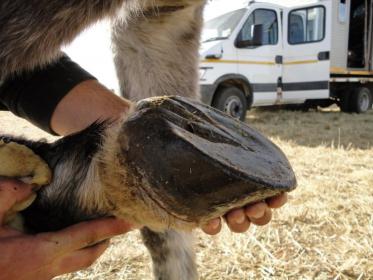Hi guys, I’m after some input from others with pigeon-toed horses on how to best manage them.
My horse is a 19yo ex-dressage horse that I ride a few days a week. We don’t really “do dressage” anymore as he’s got a bit of arthritis here and there, I just ride and hand-walk to keep him in light work to keep him moving.
Seeing as we’re not doing dressage, I’ve been taking him out about about on the roads, to the parks, around the property just to get him out experiencing things instead of staying in the arena. He’s always been pigeon toed and barefoot on/off for years and it’s never been a problem… until now… as he’s been lame for about a month.
I’ve gotten my vet involved and had a lameness workup. nerve blocks showed he has heel pain in both front feet but xrays show no major problems in the feet except a bit of wear and tear, but not around the heel. no navicular issues or anything. nothing drastic, so we were referred to a specialist farrier for help with his feet.
So the diagnosis seems to be that because of his pigeon toes, his digital cushion isn’t as effective as a straight-legged horse’s would be. his weight drops down his leg and then over the side of his heels instead of into his cushion. this is partially crushing his heels and ultimately just not providing enough support to his foot, which is exacerbated on hard ground.
Turns out that an arena surface is quite forgiving on the feet, particularly if your horse has a conformational defect that would otherwise affect their soundness!
The farrier seems brilliant, best traditional farrier I’ve ever used and has been shoeing my horse for a couple months now. He’s put my horse in straight bar shoes with pads and silicone injected into the spacing, as well as added slight heel extensions to the shoes, where my horse’s heel would be if they weren’t crooked and squished.
It has definitely made an improvement but he’s still lame on hard ground. The farrier has a few other things to try but they depend on how well his heels grow in over the coming months.
My country is affected by drought at the moment and so the ground is rock hard. It’s inescapable, I’ve checked other properties and every is bone dry and rock hard ground, so moving him somewhere softer is not an option.
My vet has just given my horse injections into his feet to try and help with the discomfort.
At this stage I’m just not sure what to do. My goals are not to make this horse competitive in any way, I just want to keep him sound and in light work as he ages, so as to keep his body limber. Not confined to an arena, I want him to go out and experience things, trails, parks, just life outside an arena and something other than dressage. But his feet may not be up to it.
I have full faith in the vet and farrier looking after this horse, that’s not the issue, I’m just not sure what else I can ‘do’ with an elderly horse whose wear and tear is now limiting my options to work him. I don’t really believe in full retirement. I’ve done it before and ended up with stiff unhappy horses who break down even faster because they’re not using their bodies. I do think that ongoing light exercise is important for as long as possible. But pigeon toes are a new thing for me and I didn’t realise how much of an issue they can be outside of the cushy confines of an arena.
Any advice or suggestions would be great as I tend to just like to hear other peoples’ thoughts sometimes. Oh and my horse is on a monthly injected arthritis injection, an oral joint gel as well as the usual gluco/msm/chondroitin/glm powder supp.






